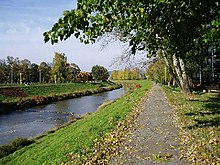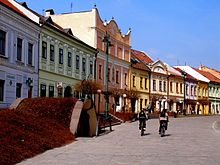Prešov
Other alternative names of the city include Preschau (in German), Eperjes (in Hungarian), Preszów (in Polish), Peryeshis (in Romani), Пряшев (Pryashev) (in Russian), Пряшово (Pryashovo) (in Rusyn)[c] and Пряшів (Priashiv) (in Ukrainian).
The city is a seat of a Greek Catholic metropolitan see and of the primate of the autocephalous Orthodox Church of the Czech Lands and Slovakia.
After the Mongol invasion in 1241, King Béla IV of Hungary invited German colonists to fill the gaps in population.
It was at the front line in the 1604–1606 Bocskai uprising, when Imperial Army commander Giorgio Basta retreated to the town after failing to take Košice from the Protestant rebels.
In late January 1657, Transylvanian Prince George II Rákóczi, a Protestant, invaded Poland with army of some 25,000 which crossed the Carpathians on the road from Prešov to Krosno.
In 1687 twenty-four prominent citizens and noblemen were executed, under a tribunal instituted by the Austrian general Antonio Caraffa,[8] for supporting the uprising of Imre Thököly: "The city particularly suffered during the religious conflicts of the seventeenth century, when it had a reputation for Protestant anti-Habsburg sentiment.
In 1687, General Carafa, an emissary of the Austrian emperor, imprisoned a group of local noblemen suspected of insurrection in a former wine warehouse off the square now known as Caraffa's Prison.
During World War II, the nearby town of Košice again became part of the Kingdom of Hungary as a result of the First Vienna Award.
Outside the sole functioning synagogue, on Švermova just off the main square, is a memorial to the 6,400 Jews from Prešov and the surrounding region who died in the Holocaust.
The first vogt in the city of Prešov, whose name has been preserved, was Hanus called Ogh, who is mentioned in historical sources as early as 1314.
The local military garrison consisted of several units of the joint army and militia, the largest of which was the 67th Imperial and Royal Infantry Regiment.
After the arrival of military reinforcements, the insurgents were arrested and despite the fact that there were no casualties during the riots, the statistical court sentenced the participants in the uprising to death.
From 4 July 1945, shortly after the end of World War II, military units in the territory of Czechoslovakia were reorganized according to the model of the Red Army.
[21][22][clarification needed] Prešov lies at an altitude of 250 m (820 ft) above sea level and covers an area of 70.4 km2 (27.2 sq mi).
[23] It is located in north-eastern Slovakia, at the northern reaches of the Košice Basin, at the confluence of the Torysa river with its tributary Sekčov.
Mountain ranges nearby include Slanské vrchy (south-east), Šarišská vrchovina (south-west), Bachureň (west) and Čergov (north).
However, not only the number of mainstream successful musicians contributed to the musical life of the city, in the past and today, but also more or less (un)known groups and musical subcultures, steadily operating in the city foothills (genres: metal, punk, alternative, hip-hop, R&B, gospel, rock, pop-rock, folk, jazz, country, and possibly others), concert rooms and clubs (Véčko, Bizarre, Christiania, City Club, Stromoradie, Za siedmimi oknami, Wave, Ester rock club, Netopier, Staré Mexiko, Insomnia, Ponorka, ENCORE), rock shows of bands with a long tradition (Rocková liga, vyše 20. ročníkov, Prešovský študentský Liverpool, 6. ročníkov, Rebrík) but also festivals (Sigortus, Dobrý festival, (t)urbanfest, ImROCK FEST, East Side Music Festival, Festival zlej hudby, Farfest, Jazz Prešov).
The celebrations usually include open-air concerts right in the center on Hlavná street, whereas several guests from the domestic and European alternative scene took turns throughout the years.
; Laura a její tygři (Czech Republic), Srečna Mladina (Slovenia), Squartet (Italy), but also Slovak groups Heľenine Oči, Chiki liki tu-a, Arzén, Mango Molas, Alter Ego, Kapátske chrbáty a Komajota.
Completion of the construction of the 1st stage (PO west-PO north) of the northern bypass R4 is planned for the summer of 2023[needs update] and the 2nd stage (PO north-PO east) is now under the tender with planned opening in 2027. International routes of European importance E50 and E371, first class roads I/18, I/68 and I/20 and second class road 546 pass through Prešov.
In 2017, the last stage of the so-called Embankment communication (Nábrežná komunikácia) was finished, including the reconstruction of the intersection at ZVL, which relieved the city center of transit traffic.
Already in the first year of operation, the Prešov public transport buses went beyond the city limits to the municipalities of Šarišské Lúky, Nižná Šebastová, Haniska and Solivar.
A new depot for trolleybuses and buses was completed in Šarišské Lúky, where the entire vehicle fleet as well as the company's administration moved.
Bus transport recorded a quantitative development, when buses also started to run to Táborisko, Šidlovec, Cemjata, Pod Kamennou baňou street and Sídlisko III.
In terms of quality, however, this mode of transport has struggled with constant difficulties such as the lack of vehicles, their low capacity and breakdown.
In 2007, the main railway station in Prešov was modernized, and in 2019, the pre-station area was reconstructed, including the underpass under Masarykova street, as well as MHD (Public transport) stops.
Their completion was ensured by the cycling connection of Sídlisko III with the city center and with the Sekčov and Šváby housing estates.
The routes lead through Malkovská hôrka, to the recreation center Cemjata (Kyslá and Kvašná voda), to Borkút and it is also possible to get to the Calvary in Prešov.
There are also ZOC Koral,[50] Solivaria SC[51] and the nearby Ľubotice Retail Park,[52] with an additional area together of cca 40.000 m2 (430.56 sq ft).
[53] It is an exotic place in a cozy and calm city area, consisting of a luxury hotel with a restaurant and outside swimming pools.







































